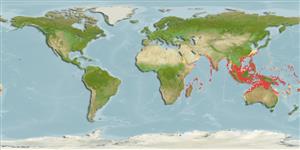Common names from other countries
>
Eupercaria/misc (Various families in series Eupercaria) >
Caesionidae (Fusiliers) > Caesioninae
Etymology: Pterocaesio: Greek, pteron = wing, fin + Latin, caesius = blue grey (Ref. 45335).
More on author: Bleeker.
Environment: milieu / climate zone / depth range / distribution range
Écologie
marin récifal; non migrateur; profondeur 1 - 100 m (Ref. 37816). Tropical; 30°N - 32°S, 32°E - 178°W (Ref. 402)
Indo-West Pacific: East Africa (excluding the Red Sea and Arabian (Persian) Gulf) eastward to Fiji. Reported from the Ryukyu Islands (Ref. 559).
Taille / Poids / Âge
Maturity: Lm ? range ? - ? cm
Max length : 21.0 cm TL mâle / non sexé; (Ref. 402); common length : 13.8 cm SL mâle / non sexé; (Ref. 37816)
Épines dorsales (Total): 10 - 11; Rayons mous dorsaux (Total): 14-16; Épines anales 3; Rayons mous anaux: 11 - 13. Variable body coloration, dark red to silvery, paler ventrally with lateral line darker; often yellowish snout and eyes. Caudal fin tips distinctly black or reddish black (Ref. 48636). 4-5 scales on cheek; 21-29 predorsal scales; scaled dorsal and anal fins. Upper peduncular scale rows usually 11 (10-12); lower peduncular scale rows usually 15 (13-17). ventrolateral surface of basioccipital with a broad process for attachment of Baudelot's ligament. Post maxillary with 2 processes; posterior end of maxilla tapered (Ref. 1723). Head length 3.0-3.5 in SL; body depth 3.6-4.8 in SL (Ref. 90102).
Ranges widely around coral reefs (Ref. 58652), sometimes forming schools with other Pterocaesio species. Feeds on zooplankton in midwater aggregations. Oviparous, with numerous, small pelagic eggs (Ref. 402). Also caught mostly by drive-in nets. Important tuna baitfish.
Life cycle and mating behavior
Maturité | Reproduction | Frai | Œufs | Fécondité | Larves
Carpenter, K.E., 1987. Revision of the Indo-Pacific fish family Caesionidae (Lutjanoidea), with descriptions of five new species. Indo-Pac. Fish. (15):56 p. (Ref. 1723)
Statut dans la liste rouge de l'IUCN (Ref. 130435)
CITES (Ref. 128078)
Not Evaluated
Menace pour l'homme
Harmless
Utilisations par l'homme
Pêcheries: commercial; appât: usually
Plus d'informations
RéférencesAquacultureProfil d'aquacultureSouchesGénétiqueElectrophoresesHéritabilitéPathologiesTraitementMass conversion
Outils
Articles particuliers
Télécharger en XML
Sources Internet
Estimates based on models
Preferred temperature (Ref.
115969): 25.9 - 28.4, mean 27.5 (based on 310 cells).
Phylogenetic diversity index (Ref.
82804): PD
50 = 0.5002 [Uniqueness, from 0.5 = low to 2.0 = high].
Bayesian length-weight: a=0.00977 (0.00539 - 0.01773), b=3.11 (2.95 - 3.27), in cm Total Length, based on LWR estimates for this species & Genus-body shape (Ref.
93245).
Niveau trophique (Ref.
69278): 3.4 ±0.45 se; based on food items.
Résilience (Ref.
120179): Haut, temps minimum de doublement de population inférieur à 15 mois (K=1.05).
Fishing Vulnerability (Ref.
59153): Low vulnerability (14 of 100).
